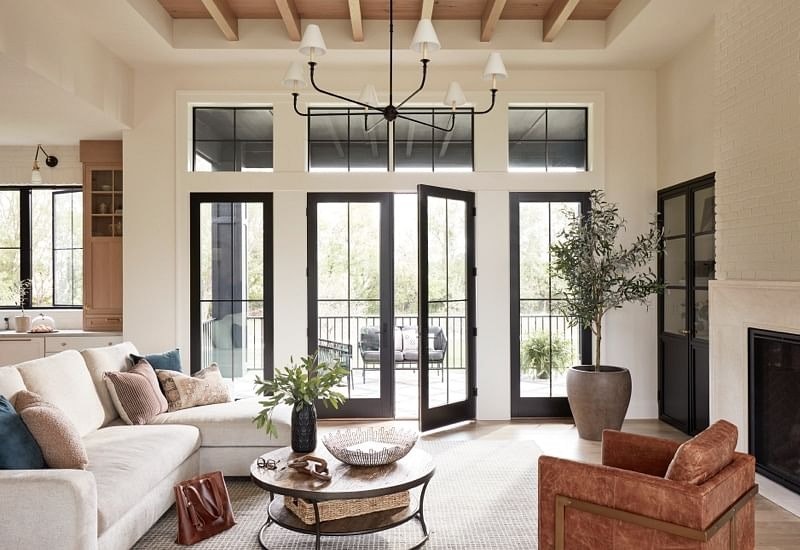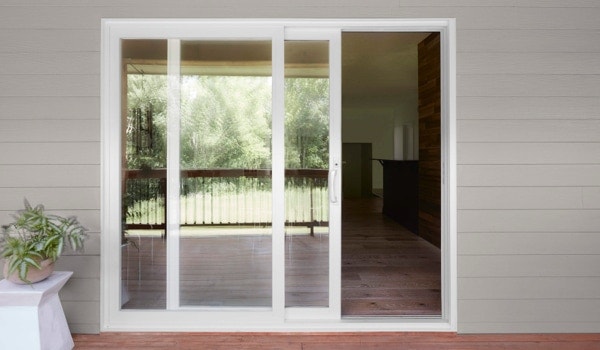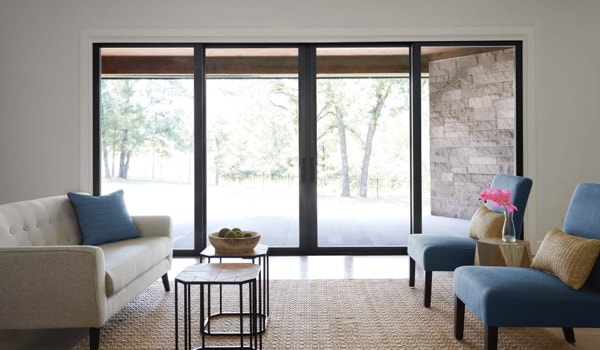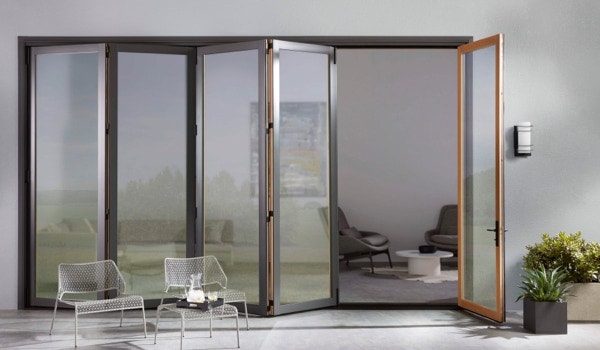Patio Door Buying Guide: How to Weigh All Your Options
Posted
on March 1, 2021

Patio doors serve many purposes. Sure, they give you a back entrance. But your average door can say the same. Patio doors do so much more.
They make your space feel more open — and open it up to the outdoors. They fill your home with the natural light and beauty emanating from the environment. And they’re much more customizable, offering flexibility not just in how the door looks, but how it opens.
So when you’re buying a patio door, there’s a lot more to consider to select the one that complements your home.
What to Consider When Buying Patio Doors
1. Space – Inside and Out
Before you start shopping for patio doors, take an accurate measurement. This immediately helps narrow down your options. If you’re looking to create a bigger opening or install a door where there wasn’t one before, measure the wall space to get your ideal size.
You should also measure the space directly in front of the door (or where the door will be). Stick some tape on the floor to map out walkways and room to operate the door. Do this both inside your home and on your deck or patio. Ask yourself:
- How much space is needed for an inswing or outswing?
- Is there room to get in and out easily?
- Do you have enough space on both sides of the door?
- Are you okay with portions of the patio door being covered by furniture?
- How much will you use the door?
Along with your measurements, the answers to these questions can help you pinpoint which patio door style fits both your wants and needs.

2. Functionality – Sliding, Swinging or Folding
Most front doors open one way: inward on a hinge, giving a warm welcome to anyone who enters your home. Patio doors can open in one of three ways:
- Sliding patio doors glide on a track within the frame, creating an opening as wide as the glass panel. Multi-slide patio doors have the same function, just more panels.
- Swinging patio doors operate on a hinge like a regular door. But you get to choose which way they swing — inward into your home or outward onto the patio.
- Folding patio doors have both hinges and tracks. Glass panels fold on the hinge and then glide along a track to stack up at the sides of the opening.
To have space for a French patio door, you need to make room for that swinging motion, whether it’s on one or two panels. Smaller, older homes may only have enough room for a single hinged door. But most homes have a two-panel sliding glass door, so you can stick with sliding panels or opt for two swinging or folding doors instead.
More wall space means more options. You can get a multi-slide or bifold patio door with up to 10 panels for the widest possible connection between your indoor and outdoor living spaces. Large patio doors appear and function more like moveable glass walls.
3. Materials – Wood, Fiberglass or Vinyl
Patio doors are like large, functional windows. It should come as no surprise that they’re most commonly made of the same three materials:
- Wood patio doors benefit from the natural properties of wood for excellent insulation, exceptional energy efficiency and warm, beautiful textures.
- Fiberglass patio doors are stronger and more durable, meaning their wood-like finish has lasting performance — even in extreme conditions.
- Vinyl patio doors combine easy care and energy efficiency in strong, durable doors at a more affordable price.

4. Style – Traditional or Contemporary
Your choices of materials and functionality inform the style of the patio door. Vinyl is simpler and more modern. As an older, popular material, wood is a more traditional choice. Fiberglass can go either way, leaning into a sleek aesthetic or emphasizing its faux wood features. As for functionality, swinging and standard sliding glass doors are historic choices while folding patio doors and multi-slide patio doors are modern innovations.
No matter what your door is made of or how it opens, there’s still a lot more room to customize its style.
- Patio door handles come in a variety of shapes and finishes to fit the old world or the new.
- Patio door grilles can be customized to fit any architectural style from the top row grids of the Victorian era to the perimeter grid patterns of Prairie-style homes.
- Stained or painted frames allow you to match the color and finish of the rest of your home, inside and out.
For contemporary patio doors, choose options with minimal, clean lines and polished chrome or brushed metal finishes. A traditional or historic look can incorporate stained finishes, bronze hardware and rectangular grille patterns.
5. Treatments – Shades, Curtains or Blinds
You might not consider how you’ll decorate a patio door until it's in your home. But it’s important to think about patio door treatments ahead of time to give you the most options.
- Patio door curtains are a traditional choice, offering a soft, elegant feel and the most options to match your interior design.
- Vertical patio door blinds are another popular option, as the long, thin fabric panels are easily adjusted to let in natural light.
- Sliding patio door shades are large, flat, vertical panels of fabric that glide along a track to provide light coverage over the glass patio door panels.
- Patio doors with built-in blinds are an easy-care option that lets you control the light and privacy without the hanging treatments that can clutter the interior of your home.
Take them into account during your measurements so that you can order a door and custom-sized treatments at the same time. Think about how curtains and blinds will interact with your preferred patio door style. Will they block visibility or the flow of traffic? Will they interfere with the function of the patio door?
You can certainly opt against any patio door treatment at all. Especially if you love the sight of the outdoors or prefer a modern look inside. Large, unobstructed panes of glass, free of treatments, are a defining feature of modern style.

Tips for Choosing a Patio Door
As you work through all the considerations for buying a patio door, you may feel overwhelmed by your options. But as you learn more about your choices, the feeling fades and your ideal patio door takes shape in your mind. Follow these tips to explore your patio door options thoughtfully and strategically:
- Talk to an expert. Consult with your local Pella window and door professional. They help homeowners with patio door projects every single day. So they have the expertise to help you decide what’s best in your home.
- Ask friends and family. You can learn a lot from your inner circle, too. Everyone’s home is different, but those close to you may have similar lifestyles. Inquire about their patio doors, what they like and what they’d like to change. Bonus if they've recently gone through the patio door replacement process themselves!
- Get an accurate measurement. If you don’t trust your measuring skills, leave it to the experts. As part of your free in-home consultation, you’ll get a detailed measurement. You can even get multiple measurements if you’re also considering a patio door that’s larger than the one you have.
- Explore patio door projects. Anyone who’s been through a patio door project is a wealth of knowledge — even if you’ve never met them. Seeing what’s trending in your city can inspire your own project.
- Visit a showroom. Nothing beats seeing and feeling a door in person. Touch the textures. Glimpse the grains, colors and finishes. Swing, slide and fold each door. Seeing a patio door in real life helps you visualize what it will look like in your own home.
Schedule a free consultation to find windows and doors for your home.
